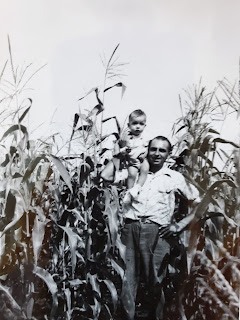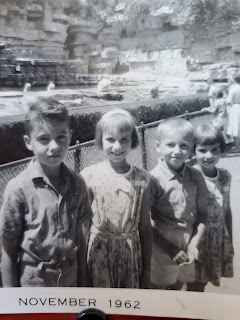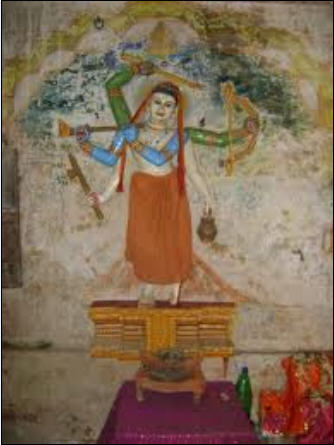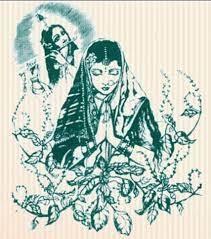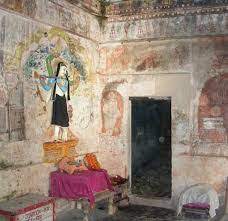 We have gathered at the lotus feet of the Pancha-tattva on this most auspicious occasion of Raghunatha dasa Gosvami’s cida-dadhi festival, the background to which can be found in his early life. Raghunatha dasa’s uncle and father, Hiranya and Govardhana Majumadara, were wealthy landlords in Bengal—almost like kings—and had a huge, opulent riverside palace, with boats that plied the river. Hiranya and Govardhana were generous and devoted to brahminical culture, and they practically maintained the entire brahman community of Nadia with their charity. Raghunatha was their only son, so naturally they put all their hopes in him to carry on the family dynasty. But from a young age, Raghunatha was attracted to Sri Chaitanya Mahaprabhu. The Majumadaras’ spiritual master was Yadunandana Acharya, a disciple of Advaita Acharya (of the Pancha-tattva) and an intimate student of Vasudeva Datta, and their family’s priest was Balarama Acharya, a dear associate of Haridasa Thakura and close friend of Yadunandana Acharya. Balarama Acharya and Yadunandana Acharya used to host Haridasa Thakura, and when Haridasa stayed in their village, Raghunatha visited him daily and received his mercy. Balarama Acharya also invited Haridasa Thakura to speak in the Majumadaras’ assembly about the glories of the holy name. Thus Raghunatha dasa had the association of these great souls, followers of Chaitanya Mahaprabhu, who would tell him about Mahaprabhu and encourage him to chant.
We have gathered at the lotus feet of the Pancha-tattva on this most auspicious occasion of Raghunatha dasa Gosvami’s cida-dadhi festival, the background to which can be found in his early life. Raghunatha dasa’s uncle and father, Hiranya and Govardhana Majumadara, were wealthy landlords in Bengal—almost like kings—and had a huge, opulent riverside palace, with boats that plied the river. Hiranya and Govardhana were generous and devoted to brahminical culture, and they practically maintained the entire brahman community of Nadia with their charity. Raghunatha was their only son, so naturally they put all their hopes in him to carry on the family dynasty. But from a young age, Raghunatha was attracted to Sri Chaitanya Mahaprabhu. The Majumadaras’ spiritual master was Yadunandana Acharya, a disciple of Advaita Acharya (of the Pancha-tattva) and an intimate student of Vasudeva Datta, and their family’s priest was Balarama Acharya, a dear associate of Haridasa Thakura and close friend of Yadunandana Acharya. Balarama Acharya and Yadunandana Acharya used to host Haridasa Thakura, and when Haridasa stayed in their village, Raghunatha visited him daily and received his mercy. Balarama Acharya also invited Haridasa Thakura to speak in the Majumadaras’ assembly about the glories of the holy name. Thus Raghunatha dasa had the association of these great souls, followers of Chaitanya Mahaprabhu, who would tell him about Mahaprabhu and encourage him to chant.
Once, when Chaitanya Mahaprabhu, after taking sannyasa, visited Shantipur, Raghunatha dasa went to meet Him. In pure love, he fell at Lord Chaitanya’s lotus feet, and the Lord, out of His mercy, blessed him with the touch of His feet. Raghunatha served the Lord for a week, and after he returned home he was mad with ecstatic love. He wanted to join Mahaprabhu in Puri, but his family would not allow him. Time and again he would run away from home to go to Puri, and every time, his father would catch him and bring him back. His father even kept five watchmen to guard him day and night, four servants to see to his comforts, and two brahmans to cook for him, so eleven people were engaged to make sure he did not go to Puri. Later, when Mahaprabhu again visited Shantipur, Raghunatha begged his father, “Please allow me to see the lotus feet of Chaitanya Mahaprabhu. Otherwise, my life will not remain in my body.” So, his father allowed him to go to Shantipur, sending many servants to accompany him. For seven days Raghunatha stayed in the Lord’s association, constantly thinking, “How will I get free from the watchmen? How will I be able to go with Mahaprabhu to Puri?” The Lord, being omniscient, could understand Raghunatha’s mind, and He reassured him with some important statements. These instructions form the background of the Panihati festival, and we shall read them as they are recorded in Sri Caitanya-caritamrta, Madhya-lila, Chapter Sixteen: “The Lord’s Attempt to go to Vrndavana.”
TEXT 237
“sthira hana ghare yao, na hao vatula
krame krame paya loka bhava-sindhu-kula
TRANSLATION
[Lord Chaitanya told Raghunatha dasa:] “Be patient and return home. Don’t be a crazy fellow. By and by you will be able to cross the ocean of material existence.
TEXT 238
“markata-vairagya na kara loka dekhana
yatha-yogya visaya bhunja’ anasakta hana
TRANSLATION
“You should not make yourself a showbottle devotee and become a false renunciant. For the time being, enjoy the material world in a befitting way and do not become attached to it.”
PURPORT by Srila Prabhupada
The word markata-vairagya, indicating false renunciation, is very important in this verse. Srila Bhaktisiddhanta Sarasvati Thakura, in commenting on this word, points out that monkeys make an external show of renunciation by not accepting clothing and by living naked in the forest. In this way they consider themselves renunciants, but actually they are very busy enjoying sense gratification with dozens of female monkeys. Such renunciation is called markata-vairagya—the renunciation of a monkey. One cannot become really renounced until one actually becomes disgusted with material activity and sees it as a stumbling block to spiritual advancement. Renunciation should not be phalgu, temporary, but should exist throughout one’s life. Temporary renunciation, or monkey renunciation, is like the renunciation one feels at a cremation ground. When a man takes a dead body to the crematorium, he sometimes thinks, “This is the final end of the body. Why am I working so hard day and night?” Such sentiments naturally arise in the mind of any man who goes to a crematorial ghata. However, as soon as he returns from the cremation grounds, he again engages in material activity for sense enjoyment. This is called smasana-vairagya, or markata-vairagya.
In order to render service to the Lord, one may accept necessary things. If one lives in this way, he may actually become renounced. In the Bhakti-rasamrta-sindhu (1.2.108), it is said:
yavata syat sva-nirvahah
svi-kuryat tavad artha-vit
adhikye nyunatayam ca
cyavate paramarthatah
“The bare necessities of life must be accepted, but one should not superfluously increase his necessities. Nor should they be unnecessarily decreased. One should simply accept what is necessary to help one advance spiritually.”
In his Durgama-sangamani, Sri Jiva Gosvami comments that the word sva-nirvahah actually means sva-sva-bhakti-nirvahah. The experienced devotee will accept only those material things that will help him render service to the Lord. In the Bhakti-rasamrta-sindhu (1.2.256), markata-vairagya, or phalgu-vairagya, is explained as follows:
prapancikataya buddhya
hari-sambandhi-vastunah
mumuksubhih parityago
vairagyam phalgu kathyate
“When persons eager to achieve liberation renounce things related to the Supreme Personality of Godhead, thinking them to be material, their renunciation is called incomplete.” Whatever is favorable for the rendering of service to the Lord should be accepted and should not be rejected as a material thing. Yukta-vairagya, or befitting renunciation, is thus explained:
anasaktasya visayan
yatharham upayunjatah
nirbandhah krsna-sambandhe
yuktam vairagyam ucyate
“Things should be accepted for the Lord’s service and not for one’s personal sense gratification. If one accepts something without attachment and accepts it because it is related to Krsna, one’s renunciation is called yukta-vairagya.” Since Krsna is the Absolute Truth, whatever is accepted for His service is also the Absolute Truth. . . .
COMMENT by Giriraj Swami
In the Bhakti-rasamrta-sindhu, Srila Rupa Gosvami enumerates sixty-four items of devotional service, beginning with guru-padasraya, taking shelter of a spiritual master; krsna-diksadi-siksanam, taking initiation and instruction from him; visrambhena guroh seva, serving him with respect; and sad-dharma-prccha, inquiring about one’s eternal duties. And at the end of the list he discusses certain items that he has not included but which one might think could or should have been included. One such item is the cultivation of vairagya (detachment), and Rupa Gosvami explains why he has not included it. He says that bhakti by nature makes the heart soft. The primary activities of bhakti, hearing and chanting about Krishna and remembering Him, make the heart soft, whereas the cultivation of speculative knowledge and performance of artificial austerities tend to make the heart hard—the exact opposite of bhakti.
The question then arises, “If we do not cultivate detachment from material things, are we meant to be attached to them?” The answer, of course, is no. Shastra says that a person absorbed in material enjoyment is far from being absorbed in Krishna. Then how do we resolve this dilemma—that we do not want to be attached to material things yet do not want to cultivate detachment from them? In reply, Rupa Gosvami says that a taste for devotional service itself will destroy one’s material attachments, without the hardness of heart caused by the practice of vairagya. And in this important verse he explains what kind of vairagya is suitable for bhakti:
anasaktasya visayan
yatharham upayunjatah
nirbandhah krsna-sambandhe
yuktam vairagyam ucyate
Anasaktasya means “without being attached,” and visayan means “material sense objects.” Without being attached, when one engages (upayunjatah) material sense objects in appropriate ways (yatharham) in relation to Krishna (krsna-sambandhe)—in devotional service—that is called proper renunciation (yuktam vairagyam ucyate).
Srila Prabhupada used to cite the example of a famous monk in India who was supposed to be so renounced that if anyone offered him money, his hand would curl and turn away. Srila Prabhupada said, “But if anyone offers us money, we will immediately take it and use it in Krishna’s service.”
The impersonalists, who have no idea of Krishna—the beauty of Krishna—or of the actual identity of the living entity as the eternal servant of Krishna, may pose as being renounced, but actually they are not. So in contrast to yukta-vairagya, Rupa Gosvami has composed a verse that describes phalgu-vairagya. The Phalgu is a river in Bihar that has the peculiar quality of appearing like dry land. On the surface is sand, but underneath is water—a real river, with a strong current. The renunciation of impersonalists who reject the world—who reject material things as maya (illusion) even when related to the Lord—is called phalgu. On the surface they appear to be renounced, but underneath is a strong current of material desire.
In the beginning of his discussion of bhakti, Rupa Gosvami poses the question of what makes one eligible—what is the adhikara—for bhakti, and he quotes a verse from the Eleventh Canto of Srimad-Bhagavatam:
yadrcchaya mat-kathadau
jata-sraddhas tu yah puman
na nirvinno nati-sakto
bhakti-yogo ’sya siddhi-dah
First, one should have faith (adau sraddha)—faith in and attraction to the messages of Krishna (mat-kathadau). And na nirvinno nati-sakto: one should not be too attached or too detached. This might also seem odd, but the Bhagavatam explains that if someone is too attached to material life, they will be unable to take to bhakti but will be inclined to fruitive activities (karma), and if they are too averse, too negative, they will take to jnana, impersonal speculation. For bhakti, one should be neither too attached nor too detached, too disgusted with material life.
yadrcchaya mat-kathadau
jata-sraddhas tu yah puman
na nirvinno nati-sakto
bhakti-yogo ’sya siddhi-dah
“If somehow or other by good fortune one develops faith in hearing and chanting My glories, such a person, being neither very disgusted with nor attached to material life, should achieve perfection through the path of loving devotion to Me.” (SB 11.20.8) In other words, one should be in the middle. Then the heart will be open to bhakti. Both sense gratification and artificial renunciation make the heart hard.
So, what did Lord Chaitanya tell Raghunatha dasa? First He said, “Don’t be a crazy fellow. Don’t be a monkey renunciant.” That is what Raghunatha should not do. Now, what should he do?
TEXT 239
“antare nistha kara, bahye loka-vyavahara
acirat krsna tomaya karibe uddhara
TRANSLATION
Sri Caitanya Mahaprabhu continued, “Within your heart you should keep yourself very faithful, but externally you may behave like an ordinary man. Thus Krsna will soon be very pleased and deliver you from the clutches of maya.
TEXT 240
“vrndavana dekhi’ yabe asiba nilacale
tabe tumi ama-pasa asiha kona chale
“You may see Me at Nilacala, Jagannatha Puri, when I return after visiting Vrndavana. By that time you can think of some trick to escape.
TEXT 241
“se chala se-kale krsna sphurabe tomare
krsna-krpa yanre, tare ke rakhite pare”
“What kind of means you will have to use at that time will be revealed by Krsna. If one has Krsna’s mercy, no one can check him.”
TEXTS 242–243
In this way, Sri Caitanya Mahaprabhu bade farewell to Raghunatha dasa, who returned home and did exactly what the Lord told him.
After returning home, Raghunatha dasa gave up all craziness and external pseudo renunciation and engaged in his household duties without attachment.
COMMENT
For one year Raghunatha dasa remained at home, acting exactly as advised by Sri Chaitanya Mahaprabhu.
bhitare vairagya, bahire kare sarva-karma
dekhiya ta’ mata-pitara anandita mana
“Raghunatha dasa was inwardly completely renounced, even in family life, but he did not express his renunciation externally. Instead, he acted just like an ordinary businessman. Seeing this, his father and mother were satisfied.” (Cc Antya 6.15)
Raghunatha dasa expertly handled a serious legal implication that could have led to his uncle’s arrest, thus saving his family from a difficult situation with the Muslim government. And because he was acting like a proper materialist, his family members were happy and relaxed their guard.
As a relatively new devotee, I really liked the image of Raghunatha dasa Gosvami in Vrindavan, although I did not know what his internal consciousness actually was. And I wanted to be like him—a gosvami in Vrindavan, staying one night under one tree and another night under another tree. I never said anything to Srila Prabhupada, but because he was empowered by the Lord, he could understand my mind—just as Lord Chaitanya could understand Raghunatha’s mind. One day I was sitting before Prabhupada in his room in Juhu—I hadn’t said anything—and he just looked at me and said, “First you manage your father’s property like Raghunatha dasa Gosvami, then you go to Vrindavan and be a gosvami.” At the time, Srila Prabhupada was very concerned about the Juhu project.
Finally, although Raghunatha dasa was still being watched by guards, he got the idea to meet Nityananda Prabhu in nearby Panihati. He thought, “Let me see Nityananda Prabhu, even if the guards come with me. At least let me see Lord Nityananda.”
Now we shall read from Sri Caitanya-caritamrta, Antya-lila, Chapter Six: “Lord Caitanya Meets Raghunatha dasa Gosvami.”
TEXTS 35–41
In this way Raghunatha dasa passed one year exactly like a first-class business manager, but the next year he again decided to leave home.
He got up alone one night and left, but his father caught him in a distant place and brought him back.
This became almost a daily affair. Raghunatha would run away from home, and his father would again bring him back. Then Raghunatha dasa’s mother spoke to his father as follows.
“Our son has become mad,” she said. “Just keep him by binding him with ropes.” His father, being very unhappy, replied to her as follows.
“Raghunatha dasa, our son, has opulences like Indra, the heavenly king, and his wife is as beautiful as an angel. Yet all this could not tie down his mind.
“How then could we keep this boy home by binding him with ropes? It is not possible even for one’s father to nullify the reactions of one’s past activities.
“Lord Sri Caitanya Mahaprabhu has fully bestowed His mercy on him. Who can keep home such a madman of Caitanyacandra?”
COMMENT
Sometimes the parents of Prabhupada’s disciples also thought that their children had become mad. Once, two brothers, Bruce and Greg Scharf (later initiated as Brahmananda and Gargamuni), joined Srila Prabhupada’s movement, and their mother came to Prabhupada and complained that her boys had become crazy. After speaking with her for some time, he invited her to join him in the temple room, and there he gave a class: “Who is Crazy?” He said, “What is the definition of ‘crazy’? A crazy person is someone who doesn’t know who he is.” For example, if I think I am Napoleon Bonaparte or Theodore Roosevelt or Mahatma Gandhi—if I don’t know who I am—that means I am crazy. Srila Prabhupada concluded, “So anyone who thinks he is the body is crazy, because he doesn’t know who he is. So who is crazy? Are these boys crazy—these devotees—or are you crazy?”
TEXTS 42–44
Then Raghunatha dasa considered something in his mind, and the next day he went to Nityananda Gosani.
In the village of Panihati, Raghunatha dasa obtained an interview with Nityananda Prabhu, who was accompanied by many kirtana performers, servants, and others.
Sitting on a rock under a tree on the bank of the Ganges, Lord Nityananda seemed as effulgent as hundreds of thousands of rising suns.
COMMENT
Narottama dasa Thakura sings, nitai-pada-kamala koti-candra-susitala: “The lotus feet of Lord Nityananda are as cooling as hundreds of thousands of moons.” And here He is described as being “as effulgent as hundreds of thousands of rising suns.” He Himself is like the sun and the moon.
TEXTS 45–47
Many devotees sat on the ground surrounding Him. Seeing the influence of Nityananda Prabhu, Raghunatha dasa was astonished.
Raghunatha dasa offered his obeisances by falling prostrate at a distant place, and the servant of Nityananda Prabhu pointed out, “There is Raghunatha dasa, offering You obeisances.”
Hearing this, Lord Nityananda Prabhu said, “You are a thief. Now you have come to see Me. Come here, come here. Today I shall punish you!”
COMMENT
Out of humility, Raghunatha dasa had offered obeisances from a distance, but Lord Nityananda, in a humorous mood, said that he was like a thief—one who hides in the shadows on the outskirts. At this time Raghunatha dasa was a young man, only about twenty-two years old.
TEXTS 48–51
The Lord called him, but Raghunatha dasa did not go near the Lord. Then the Lord forcibly caught him and placed His lotus feet upon Raghunatha dasa’s head.
Lord Nityananda was by nature very merciful and funny. Being merciful, He spoke to Raghunatha dasa as follows.
“You are just like a thief, for instead of coming near, you stay away at a distant place. Now that I have captured you, I shall punish you.
“Make a festival and feed all My associates yogurt and chipped rice.” Hearing this, Raghunatha dasa was greatly pleased.
COMMENT
This was a humorous request, because Raghunatha dasa was practically a prince and chipped rice is a most simple food. It would be as if Mukesh Ambani, now one of the richest men in the world, came to the temple and said, “I want to do some service” and Tukarama Prabhu, the temple president, replied, “Okay, buy puffed rice for all the devotees.” That would be a joke. Imagine: Raghunatha dasa is living in unlimited opulence, like Indra, the king of heaven, and Nityananda Prabhu says, “Oh, I am going to punish you! You have to serve chipped rice and yogurt to all My associates.”
TEXTS 52–54
Raghunatha dasa immediately sent his own men to the village to purchase all kinds of eatables and bring them back.
Raghunatha dasa brought chipped rice, yogurt, milk, sweetmeats, sugar, bananas, and other eatables and placed them all around.
As soon as they heard that a festival was going to be held, all kinds of brahmanas and other gentlemen began to arrive . . .
COMMENT
Just like here, you all heard that there was a festival, and so you came.
TEXT 54 (continued)
Thus there were innumerable people.
TEXTS 55–60
Seeing the crowd increasing, Raghunatha dasa arranged to get more eatables from other villages. He also brought two to four hundred large, round earthen pots.
He also obtained five or seven especially large earthen pots, and in these pots a brahmana began soaking chipped rice for the satisfaction of Lord Nityananda.
In one place, chipped rice was soaked in hot milk in each of the large pots. Then half the rice was mixed with yogurt, sugar, and bananas.
The other half was mixed with condensed milk and a special type of banana known as canpa-kala. Then sugar, clarified butter, and camphor were added.
After Nityananda Prabhu had changed His cloth for a new one and sat on a raised platform, the brahmana brought before Him the seven huge pots.
On that platform, all the most important associates of Sri Nityananda Prabhu, as well as other important men, sat down in a circle around the Lord.
COMMENT
Next the author lists various great associates of Nityananda Prabhu who were present. Nityananda Prabhu is the incarnation of Balarama, just as Sri Chaitanya Mahaprabhu is the incarnation of Krishna, and Balarama is always associated with His cowherd boyfriends. Many of Lord Balarama’s cowherd boyfriends in krsna-lila descended on earth at the time of gaura-lila and took birth in brahman and other families. Many of them became associates of Lord Nityananda, and one of them, Uddharana Datta Thakura, who was also with Him at Panihati, appeared in a family that was related to the family in which Srila Prabhupada later appeared.
TEXTS 64–66
Hearing about the festival, all kinds of learned scholars, brahmanas, and priests went there. Lord Nityananda Prabhu honored them and made them sit on the raised platform with Him.
Everyone was offered two earthen pots. In one was put chipped rice with condensed milk, and in the other chipped rice with yogurt.
All the other people sat in groups around the platform. No one could count how many people there were.
COMMENT
Each person was supplied two pots, one with chipped rice and yogurt and one with chipped rice and condensed milk. Raghunatha dasa kept purchasing more chipped rice, more milk and yogurt, more bananas and other fruits, and more sweets. Not only did brahmans hear about the festival and come to partake, but merchants heard too and came to sell their goods. Raghunatha dasa would buy their chipped rice and yogurt and sweets and bananas, and then he would feed them the very same food. The multitude of people eventually occupied all the space on the land, and when there was no more place to sit, people started to stand on the bank of the Ganges and eat. And when all the space on the bank was taken, people began to stand in the water of the Ganges and eat their chipped rice and yogurt.
Toward the end of the feast, Nityananda Prabhu, in meditation, brought Lord Sri Chaitanya Mahaprabhu to see the fun. Lord Nityananda stood up and walked with Him amidst all the eaters. As a joke, He took a morsel of rice from each pot and put it in Chaitanya Mahaprabhu’s mouth, and Sri Chaitanya Mahaprabhu took a morsel from each pot and put it in Nityananda Prabhu’s mouth, laughing as He made Him eat it. But nobody could understand what Nityananda Prabhu was doing. Only some rare, fortunate souls could see that Lord Chaitanya was also present.
The entire pastime is very nice, but time does not allow us to read or describe it all in detail. Suffice to say, in the words of Sri Caitanya-caritamrta (Antya 6.90, 89, 88):
sri-ramadasadi gopa premavista haila
ganga-tire ‘yamuna-pulina’ jnana kaila
“All the confidential devotees who were cowherd boys, headed by Sri Ramadasa, were absorbed in ecstatic love. They thought the bank of the Ganges to be the bank of the Yamuna.”
nityananda-prabhava-krpa janibe kon jana?
mahaprabhu ani’ karaya pulina-bhojana
“Who can understand the influence and mercy of Lord Nityananda Prabhu? He is so powerful that He induced Lord Sri Caitanya Mahaprabhu to come eat chipped rice on the bank of the Ganges.”
nityananda mahaprabhu-krpalu, udara
raghunathera bhagye eta kaila angikara
“Sri Caitanya Mahaprabhu and Lord Nityananda Prabhu are extremely merciful and liberal. It was Raghunatha dasa’s good fortune that They accepted all these dealings.”
Another great devotee of Sri Chaitanya Mahaprabhu and Nityananda Prabhu was Raghava Pandita, who lived nearby in Panihati. During the festival he came and invited Nityananda Prabhu to his house for prasada, and Nityananda replied, “I belong to a community of cowherd boys, and I generally have many cowherd associates with Me. I am happy when we picnic like this by the bank of a river. So let Me eat this food here now, and in the evening I shall eat at your home.”
That evening, as promised, Nityananda Prabhu came to Raghava Pandita’s house. He performed sankirtana in Raghava’s temple and inspired all the devotees to dance. Then He Himself began to dance, thus inundating the world with ecstatic love. Sri Chaitanya Mahaprabhu personally came to see Nityananda Prabhu’s sweet, ecstatic dancing, but only Lord Nityananda could see Him. Thereafter, Raghava Pandita served Lord Chaitanya, Lord Nityananda, and Their associates a sumptuous feast, and after everyone was satisfied, he gave Raghunatha dasa the remnants of food left by Gaura and Nitai on Their plates.
kahila,—“caitanya gosani kariyachena bhojana
tanra sesa paile, tomara khandila bandhana”
He said to Raghunatha dasa, “Lord Sri Caitanya Mahaprabhu has eaten this food. If you take His remnants, you will be released from the bondage of your family.” (Cc Antya 6.123)
As stated in Sri Caitanya-caritamrta, Raghava Pandita would always prepare a plate for Sri Chaitanya Mahaprabhu, and every day Chaitanya Mahaprabhu would come and eat at Raghava Pandita’s house, sometimes allowing Raghava Pandita to see Him. On this occasion, Raghava Pandita was pleased to see that Chaitanya Mahaprabhu had come to honor the prasada at the place he had set for Him next to Nityananda Prabhu. Srila Krishnadasa Kaviraja Gosvami explains,
bhakta-citte bhakta-grhe sada avasthana
kabhu gupta, kabhu vyakta, svatantra bhagavan
“The Supreme Personality of Godhead always resides either in the heart or in the home of a devotee. This fact is sometimes hidden and sometimes manifest, for the Supreme Personality of Godhead is fully independent.
sarvatra ‘vyapaka’ prabhura sada sarvatra vasa
ihate samsaya yara, sei yaya nasa
“The Supreme Personality of Godhead is all-pervasive, and therefore He resides everywhere. Anyone who doubts this will be annihilated.” (Cc Antya 6.124–125)
The next morning, when it was time for Raghunatha dasa to return home, out of humility he did not approach Nityananda Prabhu directly but submitted his appeal through Raghava Pandita. After having taken His bath in the Ganges, Nityananda Prabhu was sitting with His associates beneath the same tree under which they had sat the previous day. Raghunatha dasa approached Him there and worshipped His lotus feet. Then, through Raghava Pandita, he submitted his desire:
TEXT 128
“adhama, pamara mui hina jivadhama!
mora iccha haya—pana caitanya-carana
TRANSLATION
“I am the lowest of men, the most sinful, fallen, and condemned. Nevertheless, I desire to attain shelter at the lotus feet of Sri Caitanya Mahaprabhu.
TEXTS 129–133
“Like a dwarf who wants to catch the moon, I have tried my best many times, but I have never been successful.
“Every time I tried to go away and give up my home relationships, my father and mother unfortunately kept me bound.
“No one can attain the shelter of Sri Caitanya Mahaprabhu without Your mercy, but if You are merciful, even the lowest of men can attain shelter at His lotus feet.
“Although I am unfit and greatly afraid to submit this plea, I nevertheless request You, Sir, to be especially merciful toward me by granting me shelter at the lotus feet of Sri Caitanya Mahaprabhu.
“Placing Your feet on my head, give me the benediction that I may achieve the shelter of Sri Caitanya Mahaprabhu without difficulty. I pray for this benediction.”
COMMENT
This is an important point: Without the mercy of Nityananda Prabhu, no one can attain the shelter of Sri Chaitanya Mahaprabhu. And Nityananda Prabhu agreed to be merciful; He placed His lotus feet on Raghunatha dasa’s head, and He praised him to the other devotees, saying that although Raghunatha’s standard of material happiness was equal to that of Indra, the king of heaven, by the mercy of Chaitanya Mahaprabhu he had no attachment to it at all. Then Nityananda asked all the devotees to bless Raghunatha dasa that he would soon attain shelter at Sri Chaitanya Mahaprabhu’s lotus feet. And He said to Raghunatha,
TEXTS 139–143
“My dear Raghunatha dasa, since you arranged the feast on the bank of the Ganges, Sri Caitanya Mahaprabhu came here just to show you His mercy.
“By His causeless mercy He ate the chipped rice and milk. Then, after seeing the dancing of the devotees at night, He took His supper.
“Lord Sri Caitanya Mahaprabhu, Gaurahari, came here personally to deliver you. Now rest assured that all the impediments meant for your bondage are gone.
“Sri Caitanya Mahaprabhu will accept you and place you under the charge of His secretary, Svarupa Damodara. You will thus become one of the most confidential internal servants and will attain shelter at the lotus feet of Sri Caitanya Mahaprabhu.
“Being assured of all this, return to your own home. Very soon, without impediments, you will attain shelter at the lotus feet of Lord Sri Caitanya Mahaprabhu.”
COMMENT
After consulting with Raghava Pandita, Raghunatha dasa privately delivered one hundred gold coins and some gold to Nityananda Prabhu’s treasurer, telling him not to mention the presentation to Lord Nityananda until Raghunatha returned home. Then, to honor Lord Nityananda’s associates—great devotees and servants and subservants—Raghunatha left another hundred gold coins and some gold with Raghava Pandita, who, in accordance with Raghunatha dasa’s instructions, prepared a list of how much would be given to each and every devotee. Then Raghunatha dasa took leave of Raghava Pandita and, filled with gratitude to Lord Nityananda for His mercy, returned home.
At home, Raghunatha dasa no longer went into the interior section of the palace; he slept on the Durga-mandapa outside. Then one night it happened, as Lord Nityananda had predicted, that Raghunatha dasa got an opportunity to escape. The Majumadaras’ and Raghunatha’s guru, Yadunandana Acharya, came at the end of the night and told Raghunatha that one of the other disciples, who had been engaged in worshipping the Deity, had left that service, and Yadunandana wanted Raghunatha to induce that brahman to take up his service again, as there was no other brahman to do it.
All the guards were asleep, and in any case Yadunandana Acharya was a trusted well-wisher of the family. So Raghunatha dasa left with Yadunandana Acharya, and after walking some distance he submitted to his spiritual master, “There is no need for you to accompany me. You may proceed to your home, and I will meet that brahman and persuade him to resume his service.” So Yadunandana Acharya went to his place, and Raghunatha dasa, after convincing the brahman to resume his service, left for Nilacala, Jagannatha Puri.
Because he knew that his family would search for him, Raghunatha took the inner route and for twelve days walked through jungles and remote villages, always thinking of the lotus feet of Sri Chaitanya Mahaprabhu and Nityananda Prabhu. On most days he did not eat anything, but because he was fixed in his determination, he did not mind. He managed with whatever little he could get, and eventually he attained the lotus feet of Sri Chaitanya Mahaprabhu in Puri, as Nityananda Prabhu had predicted.
This gives us a clue as to how we can become free from material attachments. All the scriptures say that to achieve Krishna—to achieve love for Krishna—one must be free from material attachments, but cultivating detachment is not the process. Then, what is the process? The process is service, specifically service that will please Nityananda Prabhu, because if we please Nityananda Prabhu, by His mercy we will become detached from all that is material.
ara kabe nitai-candera karuna haibe
samsara-vasana mora kabe tuccha ha’be
“When will Lord Nityananda bestow His mercy upon me so that my desire for material enjoyment will become very insignificant?” (Srila Narottama dasa Thakura, Prarthana)
Becoming free from material attachments does not necessarily mean that one must leave home, like Raghunatha dasa did. He is one example, but there are other examples of Chaitanya Mahaprabhu’s associates who did not leave home. Lord Chaitanya did not ask them to leave home, and in some cases He actually instructed them to remain at home. This is another mystery—how one can serve the Lord in either a position of renunciation or a position of opulence.
Once, Srila Prabhupada asked his guru maharaja about this question. He began by saying that Rupa Gosvami left everything—his lucrative and prestigious position as minister—for the service of Chaitanya Mahaprabhu. Tyaga. And Ramananda Raya, who was a governor and a householder, lived in great material opulence—bhoga. Both were accepted equally by Lord Chaitanya. “So what is the difference?” he asked. “Both were devotees of Chaitanya Mahaprabhu.” Thus he raised the question of bhoga and tyaga—enjoyment and renunciation.
Srila Bhaktisiddhanta Sarasvati Thakura gave a striking answer. He invoked the term prosita-bhartrka, which refers to a wife when her husband is away. In Vedic culture, when the husband was away, the wife would wear very plain clothes. She wouldn’t decorate herself or comb her hair. She would lie down and sleep on the floor, and she would live in a very austere and renounced way. And the same woman, when her husband was home, would bathe twice daily, apply oil to her body, wear beautiful clothing, and decorate herself in an attractive way. But in both cases the central point is the husband. When the husband is away she lives in that renounced way, and when the husband is present she acts in that more spirited way, but in both situations the central point is to please the husband, and so there is no difference. Thus Srila Bhaktisiddhanta explained that as devotees, we are interested neither in bhoga nor in tyaga. We are interested only in Krishna and Krishna’s service. For Krishna’s service we can give up everything, like the Gosvamis. And for the sake of Krishna’s service we can accept any opulent position, like that of Ramananda Raya, who was a governor. And either—or both—will please Sri Chaitanya Mahaprabhu.
So, becoming free from material attachments doesn’t necessarily mean that the son will leave the parents or that the husband will leave the wife or that the wife will leave the husband. It means that one is free from material bondage and acts to please the Lord. When Lord Chaitanya was discussing the perfection of life (sadhya) with Ramananda Raya, the first answer that Chaitanya Mahaprabhu accepted was that one can remain in one’s position (sthane sthitah) and chant and hear the glories of the Lord in the association of pure devotees. As stated in the Tenth Canto of Srimad-Bhagavatam, one should completely give up the process of mental speculation and just become submissive. You can remain in your position (sthane sthitah). If you are a grihastha, you can remain a grihastha. If you are a brahmachari, you can remain a brahmachari. Whatever you are, you can remain in your position but hear the messages of Krishna from the mouths of pure devotees. That is the real principle of devotional service, as accepted by Sri Chaitanya Mahaprabhu.
jnane prayasam udapasya namanta eva
jivanti san-mukharitam bhavadiya-vartam
sthane sthitah sruti-gatam tanu-van-manobhir
ye prayaso ’jita jito ’py asi tais tri-lokyam
[Lord Brahma said to Krishna:] “Those who, even while remaining situated in their established social positions, throw away the process of speculative knowledge and with their body, words, and mind offer all respects to descriptions of Your personality and activities, dedicating their lives to these narrations, which are vibrated by You personally and by Your pure devotees, certainly conquer Your Lordship, although You are otherwise unconquerable by anyone within the three worlds.” (SB 10.14.3)
Why, then, should one leave one’s family at all? One may do so only to expand one’s service to the Lord and to humanity. As Srila Prabhupada explains, “A pure devotee cuts off the limited ties of affection for his family and widens his activities of devotional service for all forgotten souls. The typical example is the band of Six Gosvamis, who followed the path of Lord Caitanya. All of them belonged to the most enlightened and cultured rich families of the higher castes, but for the benefit of the mass of population they left their comfortable homes and became mendicants. To cut off all family affection means to broaden the field of activities. Without doing this, no one can be qualified as a brahmana, a king, a public leader, or a devotee of the Lord.” (SB 1.8.41 purport)
Many of Chaitanya Mahaprabhu’s intimate associates were householders. In the Pancha-tattva, Advaita Acharya was the ideal householder. But at a certain stage it may become favorable for someone to leave his family and engage fully in the mission of the Lord. Either way, we depend on the mercy of Lord Nityananda. Whether we are with family or not doesn’t really matter. What really matters is increasing our attachment to Krishna and Krishna’s service. When one is attached to Krishna, one naturally becomes detached from maya. At the same time, if one is too preoccupied with maya, it will be hard to develop attachment to Krishna. So we should keep our lives simple. If our lives are too complicated, we will be distracted. We will have too many things on our minds to really chant and hear properly.
And the main process, as we know, is to chant the holy names of the Lord:
harer nama harer nama
harer namaiva kevalam
kalau nasty eva nasty eva
nasty eva gatir anyatha
“One should chant the holy names, chant the holy names, chant the holy names of Hari [Krishna]. There is no other way, no other way, no other way for success in the present age of Kali.” (Brhan-naradiya Purana 38.126) And to get the full benefit, one must chant with attention. If our mind is wandering while we are chanting, we will not really get the full benefit. In fact, it is an offense (nama-aparadha) to be inattentive while chanting. It is said that all the other offenses follow from inattention but that if one chants with attention—if one actually hears the holy names—then all the other offenses will be destroyed. So it is very important to chant with attention. But if we are too preoccupied with material affairs, then even while we are chanting on our beads, our minds may be thinking of other things—how much money we have in the bank, whether we have enough to pay the bills, or whatever.
So we want to keep our lives simple. Although it is hard in Kali-yuga, we want to keep our lives as clear as possible. And we should keep our chanting time exclusively for Krishna. That is our time with Krishna, with the holy name. We shouldn’t think about other things. Of course, we do have to consider other matters, but not while we are chanting and hearing about Krishna.
What also pleases Krishna—and especially Lord Nityananda—is sharing Krishna consciousness with others. At the end of the Bhagavad-gita Lord Krishna says, “Of all of My servants, he who preaches My message is most dear to Me. There will never be one as dear to Me as he, and in the end it is guaranteed that he will come to Me.” He will go back home, back to Godhead.
ya idam paramam guhyam
mad-bhaktesv abhidhasyati
bhaktim mayi param krtva
mam evaisyaty asamsayah
“For one who explains this supreme secret to the devotees, pure devotional service is guaranteed, and at the end he will come back to Me.
na ca tasman manusyesu
kascin me priya-krttamah
bhavita na ca me tasmad
anyah priyataro bhuvi
“There is no servant in this world more dear to Me than he, nor will there ever be one more dear.” (Gita 18.68–69)
In a talk in Los Angeles Srila Prabhupada paraphrased many of the principles we have just discussed. He said that in order to approach Radha and Krishna, one must get the mercy of Lord Chaitanya, and that in order to get the mercy of Lord Chaitanya, one must get the mercy of Lord Nityananda, and that in order to get the mercy of Lord Nityananda, one must approach people like Jagai and Madhai.
Jagai and Madhai were sinful people. Nityananda Prabhu and Haridasa Thakura approached them and requested them to chant the holy names, but they were so fallen that they began to blaspheme Nityananda and Haridasa. Eventually Madhai hurled a pot at Nityananda Prabhu and hit Him on the forehead, causing Him to bleed. When Chaitanya Mahaprabhu heard, He rushed to the spot, ready to kill the offenders, but Nityananda Prabhu intervened. He said, “My Lord, we are in Kali-yuga. In previous ages You came to kill the demons, but in Kali-yuga You have come to deliver them. If You kill people like Jagai and Madhai in Kali-yuga, You will have to kill everyone, because everyone will be like Jagai and Madhai—eating meat, drinking wine, and exploiting women.” He said, “In Kali-yuga, We don’t kill the demons physically. We kill their demonic mentalities.” Under the threat of Chaitanya Mahaprabhu’s Sudarsana chakra, and touched by Nityananda Prabhu’s mercy, Jagai and Madhai accepted Lord Nityananda’s mercy, surrendered to Lord Chaitanya Mahaprabhu, and took up the chanting of the holy name.
brajendra-nandana yei, saci-suta hoilo sei,
balarama hoilo nitai
dina-hina yata chilo, hari-name uddharilo,
tara saksi jagai madhai
“Lord Krsna, the son of the king of Vraja, became the son of Saci, and Balarama became Nitai. The holy name delivered all those souls who were lowly and wretched. The two sinners Jagai and Madhai are evidence of this.” (Srila Narottama dasa Thakura, Prarthana) Jagai and Madhai gave up their sinful activities, and thereafter Chaitanya Mahaprabhu never referred to their sinful pasts.
So, Srila Prabhupada instructed, “To get the mercy of Lord Nityananda, we have to approach people like Jagai and Madhai.” That means the people on the street, people everywhere; we have to approach the people. Following Lord Nityananda, who was ordered by Lord Chaitanya, we should beseech people, prabhura ajnay, bhai, magi ei bhiksa/ bolo ‘krsna,’ bhajo krsna, koro krsna-siksa: “By the order of Lord Gauranga, O brothers, I beg this one request: Chant ‘Krishna!’ worship Krishna, and follow Krishna’s instructions.” Very simple. Srila Prabhupada also quoted Chaitanya Mahaprabhu, yare dekha, tare kaha ‘krsna’-upadesa, amara ajnaya guru hana tara’ ei desa: “Wherever you go, whomever you meet, just repeat the instructions of Krishna. In this way, on My order, become a guru and try to deliver everyone in this land.” So it is not very difficult. We just repeat. Krishna says, “Surrender to Me,” and the guru says, “Surrender to Krishna.” The guru doesn’t say, “Surrender to me”—he says, “Surrender to Krishna.” It is very easy.
Srila Prabhupada’s secretary Shyamasundar and his wife, Malati, had a little girl, Sarasvati, who from the age of three or four would approach people and ask, “Do you know who Krishna is?” Our first temple in Bombay was an apartment on Warden Road, a prestigious place near the sea. Many respectable gentlemen would come, and Sarasvati would approach them and ask, “Do you know who Krishna is?” And then she would answer, “Krishna is the Supreme Personality of Godhead.” And Srila Prabhupada remarked, “She is preaching. What she says is perfect, because she is repeating what she has heard.” We just repeat what we have heard from authorities. Anyone can do it. We don’t have to be very intellectual or imaginative or creative. We just repeat. And in that way we get the mercy of Nityananda Prabhu—through Srila Prabhupada.
Srila Prabhupada is the representative of Nityananda Prabhu, and everything that we can achieve through the mercy of Nityananda Prabhu can be achieved by the mercy of Srila Prabhupada, who has taken up the mission of Nityananda Prabhu and Chaitanya Mahaprabhu, the mission of the Pancha-tattva. The spiritual master engages the disciples in such a way that they get the mercy of the Lord. And Srila Prabhupada has done that for us through ISKCON. He has created ISKCON in such a way that by practicing and preaching Krishna consciousness—by holding festivals like we are having today and have every Sunday and holy day—we get the mercy of the Lord.
But to have the potency to preach we must practice. And the most essential practice is to chant sixteen rounds with attention. One teacher commented that devotees have become very expert with their left hands, because that way, with their right hands in their bead bags, with their left hands they can dust the house or type on the keyboard of the computer. They become very expert with their left hands. But we do not want to chant like that. We want to chant sixteen good, attentive rounds, follow the four principles, and work to spread the sankirtana movement. If we chant sixteen good, offenseless rounds, follow the regulative principles, and work to our capacity to spread the sankirtana movement, Srila Prabhupada has assured us that we will go back home, back to Godhead, and serve Sri Sri Radha and Krishna and Their associates.
Srila Prabhupada has given us everything. We just have to take it. It is so simple. We just have to take it. Sometimes Srila Prabhupada would cite a cartoon in a newspaper, which depicted an old lady sitting across from her husband. The lady was requesting her husband, “Chant. Chant. Chant.” And the husband was replying, “Can’t. Can’t. Can’t.” That is our misfortune in Kali-yuga. With the same effort that it takes to refuse to chant, we could chant. That is our misfortune.
Still, devotees work tirelessly to induce people to chant. And it may be difficult to convince them. Srila Prabhupada raised the question: “Who is crazy?” People now are mad with material desires:
nunam pramattah kurute vikarma
yad indriya-pritaya aprnoti
na sadhu manye yata atmano ’yam
asann api klesada asa dehah
“People are mad after sense gratification, and they do not know that this present body, which is full of miseries, is a result of one’s fruitive activities in the past. Although this body is temporary, it is always giving one trouble in many ways. Therefore, to act for sense gratification is not good.” (SB 5.5.4)
It is very hard to make a crazy person sane. Srila Prabhupada compared our work to that of a psychiatrist in a madhouse. He is trying to help the patients, but the patients may not appreciate his efforts; in fact, they may turn against him. Still, he continues to endeavor to help them.
Of course, I am very happy with all of you here today. But you are just a small fraction of the population. Most people are out enjoying—or trying to enjoy—what they call material happiness. And because it is so hard to bring people to Krishna consciousness, the mercy one gets for making that effort is very great. And so we try our best—depending on the mercy of Srila Prabhupada and Sri Sri Gaura-Nityananda.
Srila Prabhupada ki jaya!
Sri Nityananda Prabhu ki jaya!
Srila Raghunatha dasa Gosvami ki jaya!
Nitai-gaura-premanande hari-haribol!
[A talk by Giriraj Swami on the Panihati Cida-dadhi Festival, June 15, 2008, Laguna Beach, California]



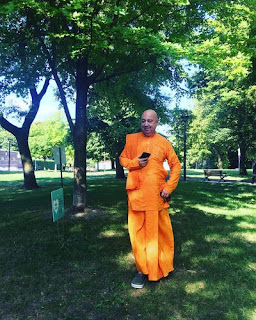
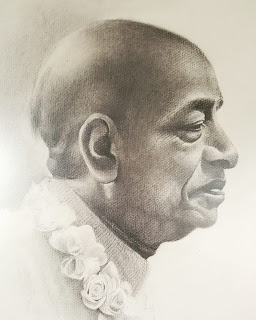

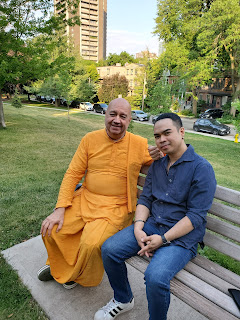

 By Mayapur Sasi dasa
By Mayapur Sasi dasa



 By Nagaraja Dasa
By Nagaraja Dasa By Vraja Vihari das
By Vraja Vihari das







